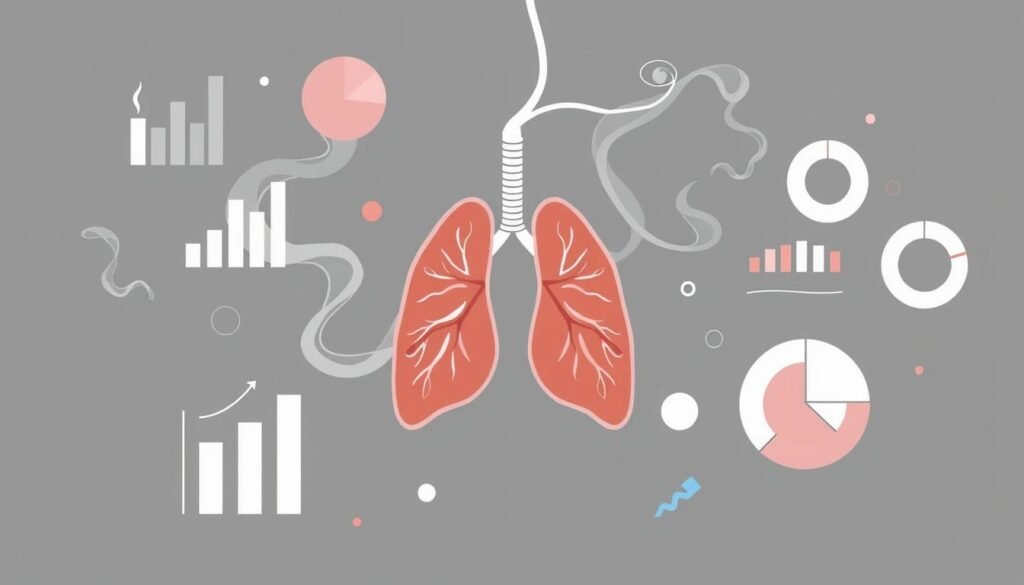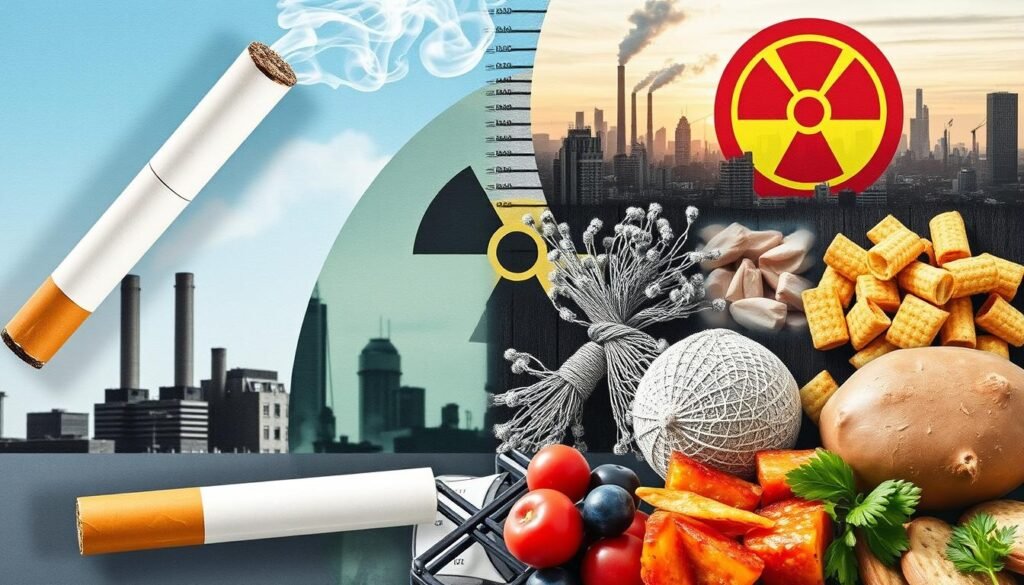Did you know smoking cigarettes causes most lung cancer cases? This fact shows how high the risk is for smokers. Those who smoke are 15 to 30 times more likely to get lung cancer than non-smokers. Yet, 12% of lung cancer patients in the U.S. never smoked. This shows that lung cancer comes from more than just smoking.
The link between smoking and lung cancer is strong. But, lung cancer in people who’ve never smoked is increasing. Things like genes, air pollution, and secondhand smoke play a role. Looking at the stats, quitting smoking helps a lot. But stopping lung cancer also needs us to look at other risks. Read more about this on this site.
Over a million people die from lung cancer each year worldwide. Knowing how smoking impacts this can help us save lives. This piece will dig into how smoking affects lung cancer risk. And it will share how we can prevent it for a better future.
Key Takeaways
- 80% to 90% of lung cancer cases are linked to cigarette smoking.
- Smokers face a significantly higher risk—15 to 30 times more than non-smokers.
- About 12% of lung cancer diagnoses occur in never-smokers.
- Rising lung cancer rates among never-smokers emphasize the need for comprehensive understanding of risk factors.
- Effective smoking cessation strategies can dramatically lower lung cancer risk.
Cigarette Smoking and Lung Cancer
Cigarette smoking is the top cause of lung cancer, involved in 90 percent of the cases. This fact shows the clear link between tobacco use and the illness. Specifically, how lung cancer develops. Cigarette smoke is filled with over 7,000 harmful chemicals. It also has at least 70 known carcinogens.
Smoking impacts more than just the smoker. Family history is a big risk factor. If you have family with lung cancer, your risk might double. This is especially true if many close family members are affected. Secondhand smoke is also dangerous. It has the same cancer-causing agents. These agents raise the lung cancer risk for people who don’t smoke but are around it.
Not every smoker gets lung cancer. In fact, only 10% to 20% of lifelong smokers get this disease. Yet, smoking isn’t the only danger. Radon in homes is also a big threat. It causes about 30% of lung cancer deaths in non-smokers.
Some smokers might have a natural defense against lung cancer. They have better DNA repair skills. This means not all smokers have the same lung cancer risk. Quitting smoking lowers your cancer risk a lot. But, even people who quit smoking still have a higher cancer risk than those who never smoked.
Understanding Lung Cancer Risk Factors
Lung cancer isn’t just linked to smoking. About 90% of lung cancers come from tobacco use. This highlights smoking’s big role. But, genes also play a part. Having family with lung cancer doubles your risk, especially if many relatives are affected.
Work environments contribute to lung cancer risks too. Most mesothelioma cases connect to asbestos, found in certain jobs like construction. Also, radon exposure at work or home causes about 30% of lung cancers in non-smokers. It’s the second biggest risk factor in the U.S.
Some lifestyle choices increase risks. For example, heavy smokers taking beta carotene supplements face more lung cancer dangers. Also, secondhand smoke is a big problem. It’s the third leading lung cancer cause in the country. The mix of these risk factors complicates how we think about prevention.
Don’t forget environmental causes. Radon and air pollution also lead to lung cancers, though they’re less talked about. They’re behind 1% to 2% of lung cancer deaths in the U.S. Understanding these less known factors is key to better prevention and awareness.
How Many People Get Lung Cancer From Smoking
Cigarette smoking is a leading cause of lung cancer. It impacts public health greatly. By understanding how smoking relates to lung cancer, we can better prevent it and plan for healthcare. It’s interesting to note that not all lung cancer cases are due to smoking.
Statistics on Smoking and Lung Cancer
In the United States, 10% to 20% of lung cancers happen in people who never smoked much. This accounts for 20,000 to 40,000 cases each year. It’s important to know about other risks too. Secondhand smoke causes around 7,300 cases yearly. About 2,900 come from radon exposure.
Looking at lung cancer patients, 36.7% are still smoking. 50.8% have quit. 12.5% never picked up a cigarette, with more women than men in this group. Women make up 15.7% and men 9.6%.
Lifetime Risk of Lung Cancer by Smoking Status
Men who smoke have a 14.8% lifetime risk of lung cancer. Women have an 11.2% chance. For those who’ve quit, the risk drops but stays significant: 7.2% for men and 5.8% for women. Never-smokers face a much lower risk: only 1.8% for men and 1.3% for women. This shows how smoking is the biggest risk factor for lung cancer.
We must focus on awareness and early detection, especially for those at high risk. For more on lung cancer risks, visit the CDC’s page. In non-smokers, adenocarcinomas are 50% to 60% of lung cancers. Knowing these stats helps improve treatment.

| Smoking Status | Lifetime Risk of Lung Cancer |
|---|---|
| Current Smokers | 14.8% (Men), 11.2% (Women) |
| Former Smokers | 7.2% (Men), 5.8% (Women) |
| Never Smokers | 1.8% (Men), 1.3% (Women) |
The Impact of Secondhand Smoke
Secondhand smoke exposure is a serious health issue for everyone. It leads to many premature deaths every year because it’s linked to smoking-related cancers. Knowing these facts helps us understand how dangerous it is.
Statistics on Secondhand Smoke Exposure
In the United States, secondhand smoke causes about 7,300 lung cancer deaths yearly among non-smokers. This fact highlights how it affects lung health. Also, non-smokers who breathe in this smoke are 20–30% more likely to get lung cancer. Other than lung cancer, secondhand smoke causes almost 34,000 early deaths from heart disease each year. People exposed to secondhand smoke have a 25–30% higher risk of heart disease and a 20–30% greater risk of having a stroke.
Effects of Secondhand Smoke on Lung Cancer Rates
Kids who breathe in secondhand smoke face many health problems, like more respiratory infections and asthma. Moreover, infants exposed to secondhand smoke have a higher chance of sudden infant death syndrome (SIDS). Studies show that being exposed to secondhand smoke when you’re very young (from birth to age 25) greatly increases your risk of lung cancer later. This information shows how harmful secondhand smoke is and why it’s important to fight against it.

The Role of E-Cigarettes in Lung Cancer
The rise of e-cigarettes has sparked considerable discussion regarding their role in lung cancer risk. With contrasting opinions on their safety compared to traditional smoking, it is essential to critically analyze the effects of smoking and how e-cigarettes fit into this landscape.
Comparative Analysis of E-Cigarettes and Traditional Smoking
Research shows worrying statistics on using both cigarettes and e-cigarettes. People doing both are four times likelier to get lung cancer than those smoking alone. Those with lung cancer were often found to have smoked and vaped, making them eight times more likely to be diagnosed than those without cancer. This shows the serious risks e-cigarettes pose, though many think they’re less harmful.
Men and women who smoke and vape face a higher risk of lung cancer. E-cigarettes put out harmful chemicals despite being seen as safer. They produce an aerosol with over 500 chemicals, including many carcinogens. Being exposed to these can lead to big health problems, such as lung disease and cancer.
Vaping’s short-term effects, like coughing and shortness of breath, can turn into long-term problems. Issues like chronic inflammation and cell damage raise cancer risks. The dual use of smoking products can lead to more harmful tobacco use as people try to handle their nicotine addiction.
The American Cancer Society urges quitting all tobacco products, including e-cigarettes, to cut health risks. Talking with healthcare providers about quitting and choosing a quit date can help users. This can help in beating addiction and lowering lung cancer risks.
| Key Statistics | Finding |
|---|---|
| Likelihood of lung cancer with dual use | 4 times higher than smoking alone |
| Increased risk in lung cancer patients | 8 times more likely to smoke and vape |
| Acute effects of vaping | Coughing and shortness of breath |
| Potential for long-term health issues | Lung disease, heart disease, and cancer |
| Total new lung cancer cases globally in 2020 | 2,206,771 |
| Estimated lung cancer deaths in 2020 | 1,796,144 |
| Rise in e-cigarette use among youth (2011-2015) | 900% increase in usage |
Other Causes of Lung Cancer
Smoking is the main cause of lung cancer, but other factors are also vital. Factors such as genetics and contact with harmful substances at work are important too. They help us understand why lung cancer happens.
Genetic Factors and Lung Cancer
If your family has a history of lung cancer, your own risk might be higher. This is because genes play a part in making some people more likely to get it. Knowing this is key, especially for those with relatives who’ve had lung cancer.
It’s crucial to know the early signs of lung cancer. Early detection can save lives. That’s why teaching high-risk families about these signs is a must.
Occupational Exposures to Carcinogens
Some jobs can increase lung cancer risk because of exposure to carcinogens. Substances like asbestos and certain chemicals are dangerous. This is particularly true for workers who also smoke.
So, companies must work to reduce employees’ exposure to these harmful substances. Protecting workers is essential to lower their risk of getting lung cancer.

| Risk Factor | Impact on Lung Cancer Risk |
|---|---|
| Smoking | Accounts for approximately 90% of lung cancer cases |
| Genetic Predisposition | Increases risk if there’s a family history of lung cancer |
| Occupational Carcinogen Exposure | Significantly heightens risk, especially in smokers |
| Radon Exposure | Second-leading cause of lung cancer, particularly in indoor environments |
Knowing the risks helps us prevent and manage lung cancer better. It’s vital to look at how genes, work environments, and lifestyles interact. This knowledge is crucial for public health efforts to lessen the number of lung cancer cases.
Lung Cancer Statistics Among Never Smokers
Lung cancer isn’t only a smoker’s issue. It also affects many who’ve never smoked. About 12.5% of lung cancer never touched a cigarette. This fact sheds light on other risk factors for lung cancer in non-smokers.
Key Findings from Recent Research
More non-smokers, especially younger women between 20 and 49, are getting diagnosed with lung cancer. In the U.S., 19% of women with lung cancer are non-smokers, unlike 9% of men. Most of these cancers are non-small cell, with adenocarcinoma being the most common type in non-smokers.
Non-smokers usually find out they have lung cancer at an average age of 67. About 36% of them have EGFR mutations, which is higher than smokers. Also, 26% show ALK mutations, much more than smokers.
Stage IV lung cancer appears in 62% of non-smokers, indicating they’re usually diagnosed late. Secondhand smoke links to 15% to 35% of non-smoker lung cancers. Being close to a smoker increases a woman’s risk by 27%. And things like asbestos can hugely increase lung cancer risk too.
Environmental and genetic factors matter as well. Cooking fumes and radon exposure are significant in some places. Relatives of non-smokers with lung cancer have a higher chance of getting cancer. Knowing these factors is key to prevention and treatment. It helps us fight lung cancer among non-smokers better.
Lung Cancer Prevention Strategies
Preventing lung cancer is key since almost 90% of cases in the U.S. are due to smoking. Telling people to stop smoking is a main way to lower the chance of getting this bad disease. It’s vital for folks to know that stopping smoking, even later in life, can cut their risk a lot.
Public health messages have made more people aware of smoking’s dangers. This has led to fewer people smoking and better health for communities.
Importance of Smoking Cessation
About 9 out of 10 lung cancer cases in both men and women are caused by smoking. Smokers have a risk about 20 times higher than non-smokers. Quitting is the first step to prevent lung cancer. People who quit can lower their risk by 30% to 60% after not smoking for ten years.
Secondhand smoke also increases the risk, which shows why it’s so important to quit smoking.
Health Benefits of Quitting Smoking
Quitting smoking not only lowers lung cancer risk but also improves overall health. People who quit have better lung function, heart health, and fewer smoking-related diseases. Catching lung cancer early with low-dose CT scans can also help save lives.
By focusing on preventing lung cancer and promoting quitting smoking, we can decrease cancer deaths. This makes communities healthier.